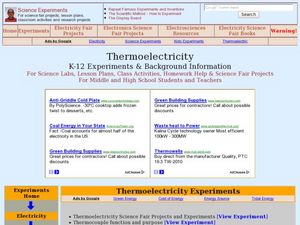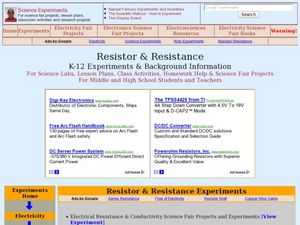Curated OER
Electric Shock: Caution!
In this electricity worksheet, students read about how electricity flows and the force that causes the flow. Students read about electric shock and then complete 3 short answer questions.
Curated OER
How Smart are You about Electricity, Batteries and Conductors?
Students create working circuits. In this electricity and circuits lesson, students make a battery, then build a flashlight and use part of the flashlight to create a conductivity tester.
Curated OER
Electric Current and Circuits
Compare the drift speed of conduction electrons in a current-carrying wire to the signal speed of changes in current. They also distinguish between DC and AC and describe how AC is converted to DC.
Curated OER
Electricity
First graders become aware of the presence of static electricity. They create static electricity using friction.
Curated OER
Electricity
Students watch instructor present demonstrations of the basic principles of static electricity, and then conduct some of their own experiments. In small groups, students build simple circuits, using batteries, to try to light up a light...
Curated OER
Electricity
In this electricity worksheet, students review electric charges and what types of materials can conduct electricity. This worksheet has 7 fill in the blank, 5 true or false, 3 multiple choice, and 5 short answer questions.
Curated OER
How Powerful is Static Electricity
Students explore energy by participating in controlled electricity experiment. In this static electricity lesson, students identify the different sources that can create energy and how static electricity can be created very easily on...
Curated OER
Multi-Talented Electrical Energy
Students explore energy conversions by demonstrating the conversion of electrical energy into light, heat, sound, and magnetic energy. Students create a simple device that converts electrical energy from batteries to heat, light, sound...
Curated OER
Energy Conversion in Electricity – Resistors and Circuits
Students explore electrical energy. In this electricity lesson, students design and build a large circuit in order to determine whether circuit size correlates with the light of a bulb.
Curated OER
Alessandro Volta: The Invention of the Voltaic Pile (The First Electric Battery)
Students conduct a series of experiments on electricity. In this physics lesson, students study the work of Alessandro Volta particularly his experiment on the the Voltaic Pail. They build their own Voltaic Pile to recreate his experiment.
Curated OER
Introduction to Electricity
In this introduction to electricity worksheet, students define several key terms related to electricity. Students list examples of conductors and insulators in a chart. Students create insulators using given materials and describe the...
Curated OER
Static Electricity
Students engage in a instructional activity that is concerned with the concept of static electricity. They conduct an experiment with balloons and make observations of how it works. The data is collected and written down and they define...
Curated OER
Using and Paying for Electricity: Understanding Your Bill
Students define key terms found on a sample electric bill. They review the past, present and future tenses of the verbs "pay," "owe," "receive" and "call." They conjugate the past, present and future tenses of the verbs "return,"...
Curated OER
Magnetism And Electricity
Students investigate the concept of electricity and how to build a circuit. They identify the presence of heat, light, sound, and the magnetic effects. Students construct the circuit and draw a diagram that gives directions for its...
Curated OER
What is Electric Current?
In this electric current worksheet, students will complete a Venn diagram comparing and contrasting the characteristics of conductors and insulators.
Curated OER
Fall 2004 Midterm Exam #1, Parts A & B
First year physics learners show what they know about electric potential, circuits, power, current, and voltage on this midterm exam. It consists of a multiple choice section, some true or false questions, and two multi-step problems to...
Curated OER
Battery fun
Conduct an experiment with batteries to make a simple circuit. Fifth graders read the provided information, consider the two circuits, and determine which one is complete. An electrically charged experiment suggestion is included. Tip:...
Creative Chemistry
Metals and Non-Metals
A half-page chart compares the properties of metals and nonmetals. Properties include appearance, melting and boiling point, density, strength, malleability, ductility, heat and electrical conductivity, and the nature of their oxides....
Museum of Science
City Circuit
Here's an electric lesson on electricity. Pupils create an electric circuit to model a city's electric system. They then test out different materials to see whether they are conductors of electricity.
Bonneville
Can Portable PV Charge Vehicles?
Take charge of learning about electric vehicles. Instructors first provide the class with information about PV modules and batteries. Learners then conduct an experiment where they connect PV modules in series and in parallel to...
Curated OER
Characteristics of Crystals
In this crystals worksheet, students complete a graphic organizer by filling in the characteristics of the different crystal types including melting/boiling point and electrical conductivity.
Curated OER
Thermoelectricity
Students conduct a series of experiments on thermoelectricity. In this physics lesson, students investigate how thermocouple works. They determine the voltage generated when different conductive materials are held at different temperatures.
Curated OER
Resistor and Resistance
High schoolers explore electrical resistance through various experiments. In this physics lesson, students calculate resistance using a mathematical formula. They explain how colors identify the resistance value of a resistor.
Curated OER
Galvanometers
Students construct their own galvanometer. In this physics lesson, students explain how it is used to detect electric current. They conduct an experiment to measure how much electricity flows through the circuit.

























